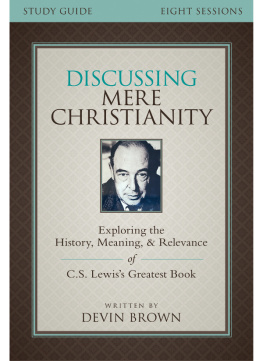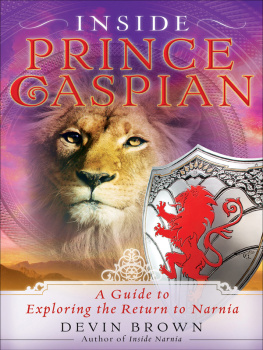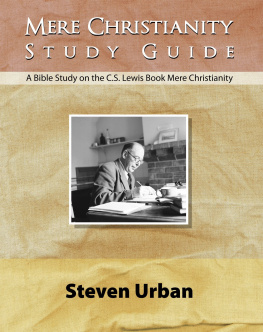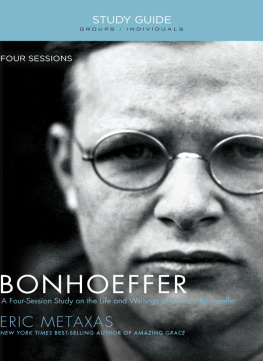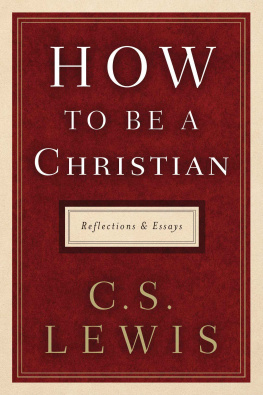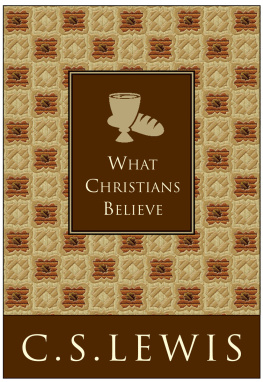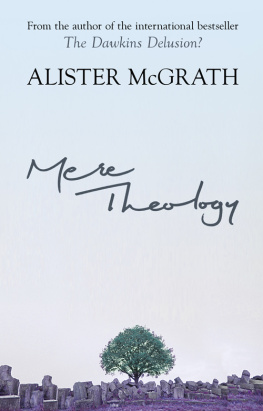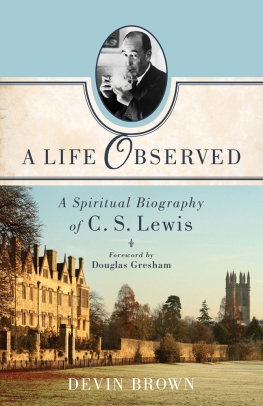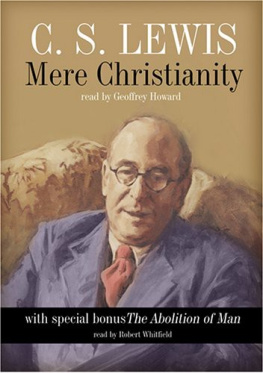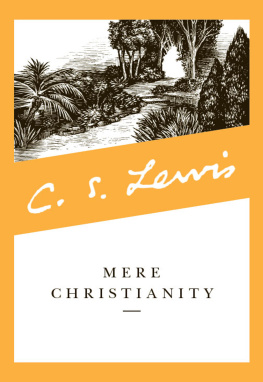ZONDERVAN
Discussing Mere Christianity Study Guide
Copyright 2015 by Zondervan
All rights reserved under International and Pan-American Copyright Conventions. By payment of the required fees, you have been granted the non-exclusive, non-transferable right to access and read the text of this e-book on-screen. No part of this text may be reproduced, transmitted, downloaded, decompiled, reverse engineered, or stored in or introduced into any information storage and retrieval system, in any form or by any means, whether electronic or mechanical, now known or hereinafter invented, without the express written permission of Zondervan.
ePub Edition June 2015: ISBN 978-0-310-69986-6
Requests for information should be addressed to:
Zondervan, 3900 Sparks Dr. SE, Grand Rapids, Michigan 49546
All Scripture quotations, unless otherwise indicated, are taken from The Holy Bible, New International Version, NIV . Copyright 1973, 1978, 1984, 2011 by Biblica, Inc . Used by permission. All rights reserved worldwide.
Scripture quotations marked ESV are taken from The Holy Bible, English Standard Version, copyright 2001 by Crossway Bibles, a division of Good News Publishers. Used by permission. All rights reserved.
Any Internet addresses (websites, blogs, etc.) and telephone numbers in this book are offered as a resource. They are not intended in any way to be or imply an endorsement by Zondervan, nor does Zondervan vouch for the content of these sites and numbers for the life of this book.
All rights reserved. No part of this publication may be reproduced, stored in a retrieval system, or transmitted in any form or by any means electronic, mechanical, photocopy, recording, or any other except for brief quotations in printed reviews, without the prior permission of the publisher.
Cover design: Ron Huizinga
Cover photography: Used by permission of The Marion E. Wade Center,
Wheaton College, Wheaton, Illinois
Interior design: Dan Dingman
First Printing April 2015
Information about External Hyperlinks in this ebook
Please note that footnotes in this ebook may contain hyperlinks to external websites as part of bibliographic citations. These hyperlinks have not been activated by the publisher, who cannot verify the accuracy of these links beyond the date of publication.
C ONTENTS
This study guide is not meant to replace reading Mere Christianity by C. S. Lewis. Its purpose is to give you a better understanding of and a greater appreciation for Lewiss beloved classic. For each of the eight sessions, there will be a reading assignment. Be sure to read the assigned chapters from Mere Christianity first and then work through the commentary and discussion questions. You will also find a number of quotations taken from other books Lewis wrote. To make the reading easier, page numbers (noted in parentheses) are given only for quotations from Mere Christianity.
This study guide has been designed to accompany the eight-session video, Discussing Mere Christianity. Each of the video sessions is hosted by Eric Metaxas and features teaching from a variety of well-known Lewis scholars and readers, as well as comments from two people who met Lewis when he was alive: Walter Hooper, who was Lewiss secretary and then became the literary executor of the C. S. Lewis estate, and Douglas Gresham, Lewiss stepson.
There are two ways to use this study guide. If you are leading a group, first watch the video together each sessions presentation is approximately 20 minutes long. Then, depending on how much time you have, select one or more of the questions provided for discussion. You may use the commentary sections however you like during the group gathering read them aloud, read them silently, summarize them, read specific portions, or read none at all, saving them for a later time. You may also want to read aloud one or more of the relevant passages from Mere Christianity.
If you are studying Mere Christianityas an individual, first complete the reading assignment and then work through each chapter in the study guide, writing out your responses to the questions in the space provided. (You may still use the video, of course!)
There is also a section for Personal Study at the conclusion of each session. This is designed for you to dig a little deeper into questions raised from the book that will enhance your reading experience of Mere Christianity.
Finally, with a limit of eight sessions designed to fit within the time constraints of a Sunday school class or book club, this study guide does not cover all of Mere Christianity. Hopefully after finishing these eight sessions, you will go on to read C. S. Lewiss greatest book in its entirety.
Ebook Instructions
In this ebook edition, please use your devices note-taking function to record your thoughts wherever you see the bracketed instructions [Your Notes] or [Your Response]. Use your devices highlighting function to record your response whenever you are asked to checkmark, circle, underline, or otherwise indicate your answer(s).
O n a frosty February morning in 1941, as England began another year of fighting in the war against Germany, C. S. Lewis turned to the stack of mail on his desk and noticed a letter from a correspondent whose name was unfamiliar to him.
Dear Mr. Lewis, the writer began, I address you by name because, although we have never met, you cannot be a stranger after allowing me and many others to know some of your thoughts and convictions in your book The Problem of Pain.
The letter was from James Welch, the Director of Religious Broadcasting for the BBC. What no one at the time could have guessed not Welch, Lewis, or anyone else was that this letter would usher in a major turning point in Christian apologetics and would be the pivot around which Lewiss tremendous Christian output would swing.
For the previous fifteen years of his life, Lewis had been a fellow at Oxfords Magdalen College. At this point, he had published two very early books of poetry. Then, after becoming a Christian in 1931, he had published The Pilgrims Regress (1933), an allegory tracing his own journey to the Christian faith, and The Problem of Pain (1940), which explored the question of how a good and all-powerful God could create a world with evil and suffering. Adding to these, partly on the prompting of his good friend, J. R. R. Tolkien, Lewis had written a science fiction novel titled Out of the Silent Planet (1938), the story of a Cambridge linguist who was kidnapped and taken to Mars where he became caught up in interplanetary spiritual warfare.
While this output was significant, Welchs use of the term many others in referring to the readers of The Problem of Pain was a relatively modest use of the phrase, referring to thousands of readers, not the millions that Lewiss books would later have.
I write to ask whether you would be willing to help us in our work of religious broadcasting, Welch continued. The microphone is a limiting, and rather irritating, instrument, but the quality of thinking and depth of conviction which I find in your book ought sure to be shared with a great many other people.
Welch suggested two possible topics. The first was for Lewis to speak about the Christian assumptions, or the lack of Christian assumptions, that underlie modern literature. The other topic Welch proposed was a series of talks loosely titled The Christian Faith as I See It by a Layman.

